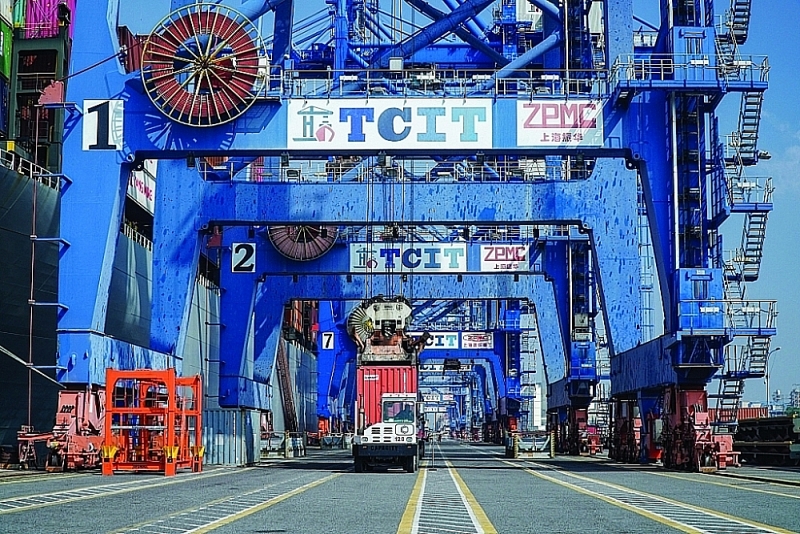Green logistics is considered an important link in “greening” the supply chain to promote sustainable development.
Grasping this trend, logistics enterprises are gradually participating in supporting the production and circulation of goods in the country as well as export and import with green criteria towards sustainable development.

Supporting for businesses
According to a report by the Vietnam Association of Logistics Services Enterprises, in recent years, despite the strong impact of the Covid-19 pandemic, Vietnam’s logistics industry still has significant growth. The average growth rate is 14 – 16% a year, the scale is US $ 40 – 42 billion/year. The number of businesses and the quality of logistics services are increasing, significantly contributing to the results of import and export of goods. This is the result of the efforts of logistics service enterprises and the Government in creating a business environment, improving the competitiveness of enterprises in the economy in general and in the field of operation. logistics services in particular as well as efforts to improve from the business itself.
Along with that, the trend of investment in the logistics industry is increasing rapidly. Many global logistics enterprises when outsourcing services also require emission standards for third-party logistics enterprises. In this context, logistics enterprises must actively invest and transform production and business models in the direction of “greening”. The good implementation of green logistics activities is not only a responsibility but also helps businesses improve their competitiveness and ensure sustainable development.
As noted, many businesses have been responding to the trend of green logistics, spreading meaningful messages about the environment and implementing sustainable development strategies.
For example, Saigon Newport has built a green port that harmonizes economic development and environmental protection with the goals of saving fuel, using clean fuel, building and applying protective and environmental friendliness; ensuring security and sustainable development according to international standards to ensure the port’s environmental quality; applying 4.0 technology to the management of activities; replacing diesel-powered lifting equipment with electric ones.
In which, Tan Cang – Cat Lai in Ho Chi Minh City is the first port in Vietnam to win the title of Green Port of the APEC Port Service Network Council.
In order to reduce pollution and traffic congestion, 80% of freight transport between Cai Mep – Thi Vai port and the surrounding area with Saigon Newport is currently carried out by barges instead of trucks.
In the northern component ports and the Mekong Delta, the development of barge transport instead of trucks has reduced CO2 emissions. The increase in water transport with a simultaneous carrying capacity of 3,000 TEUs can replace about 2,000 container trucks; The application of electronic vouchers helps to reduce the waiting time at the port from 13 minutes to 6 minutes.
The “Mobile Post Office” model of Viettel Post Corporation (Viettel Post), which has cut the intermediary stages, reducing the transportation distance by 15% and the number of transit vehicles. At the same time, Viettel Post also deployed a solution to install solar power for the warehouse system to divide, select and distribute parcels and parcels to provide energy for lighting equipment, and air conditioners.
Adding service value through digital transformation
With the development of science and technology, especially digital technology, logistics plays an increasingly central role in the supply chain. In order to increase service value and increase competitiveness globally, many logistics enterprises identify digital transformation as one of the prerequisite strategies to aim for.
For example, in March 2023, U&I Logistics pioneered the application of virtual reality technology to the bonded warehouse system, giving customers a unique and novel “virtual space – real experience” for the first time appearing in the field of logistics in Vietnam. Similarly, with the paperless office software application (Office No Paper – ONP), which has been built and deployed by U&I Logistics for more than ten years, helps to manage the flow of shipments, ensuring the shipment of customers’ goods is handled and closely monitored. In particular, the declaration process only takes 30 minutes to process since it is sent to the Customs system.
Currently, U&I Logistics is operating five business management applications according to the specific needs of customers such as warehouse management (WMS), transportation management (TMS), centralized operation management (ONP), human resource management, etc. (HRM), customer relationship management (CRM) and one administration application (BI). This is a technology ecosystem operated by U&I Logistics technical team to help serve business needs more quickly and efficiently, typically enterprises in the field of import and export.
Saigon Newport Corporation has been gradually applying artificial intelligence (AI) technology to customer care and improving customer experience. Virtual assistant (Chatbot Pi) of Saigon Newport is machine learning 25 scenarios, 301 process steps, and 4,532 sample sentences to answer customers automatically. With that knowledge equipped, Chatbot Pi can instantly respond to customer issues with a 100% response rate.
Currently, the virtual assistant Chatbot Pi has appeared on ePort and fanpage, helping to answer questions and provide information to customers, helping to reduce time and effort for customer care center consultants and improving customer service service quality of the Corporation. In the future, to meet the development requirements, Saigon Newport Corporation will integrate more technologies to establish an omnichannel model to give customers the best experience in the future.
Source: Customs News

